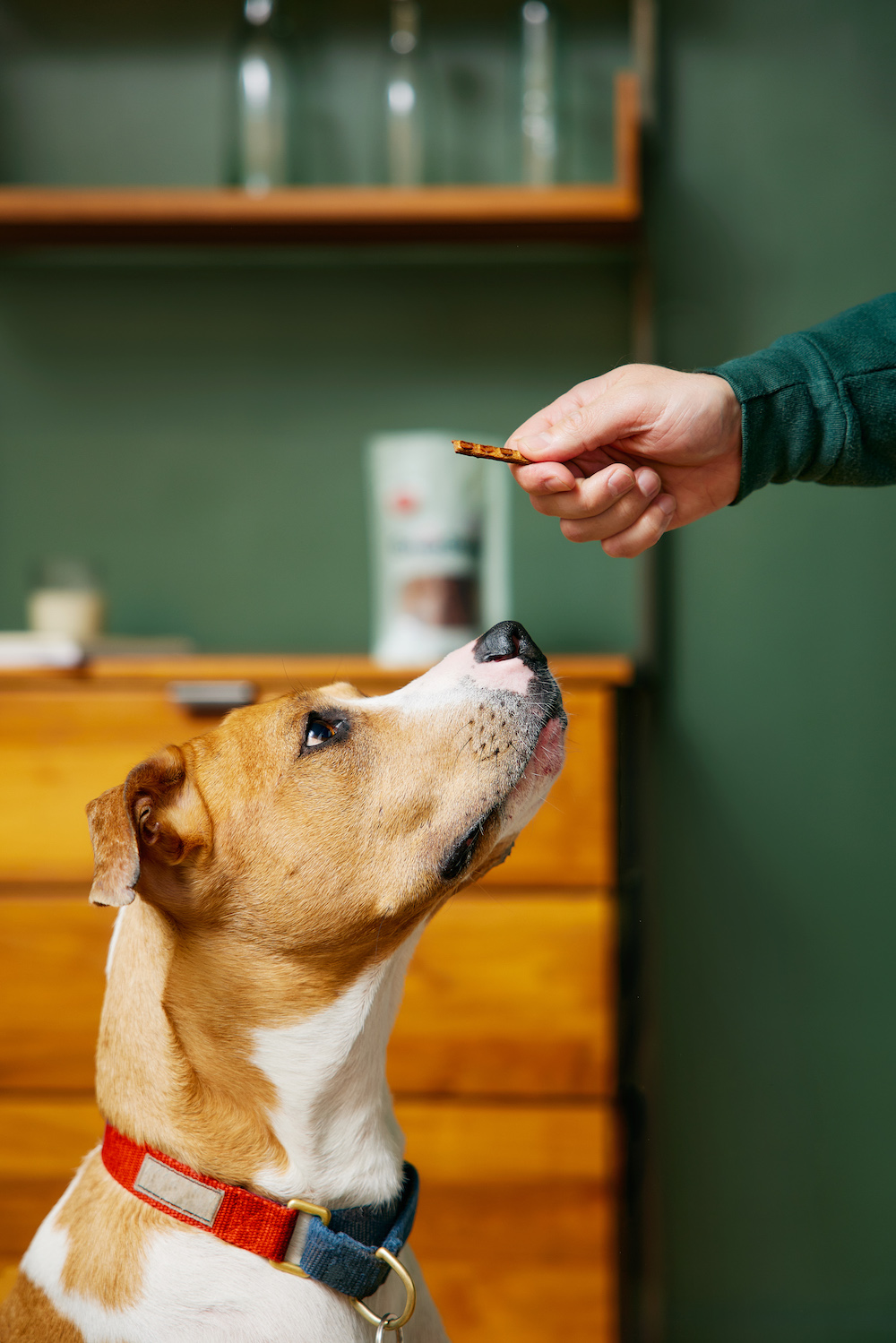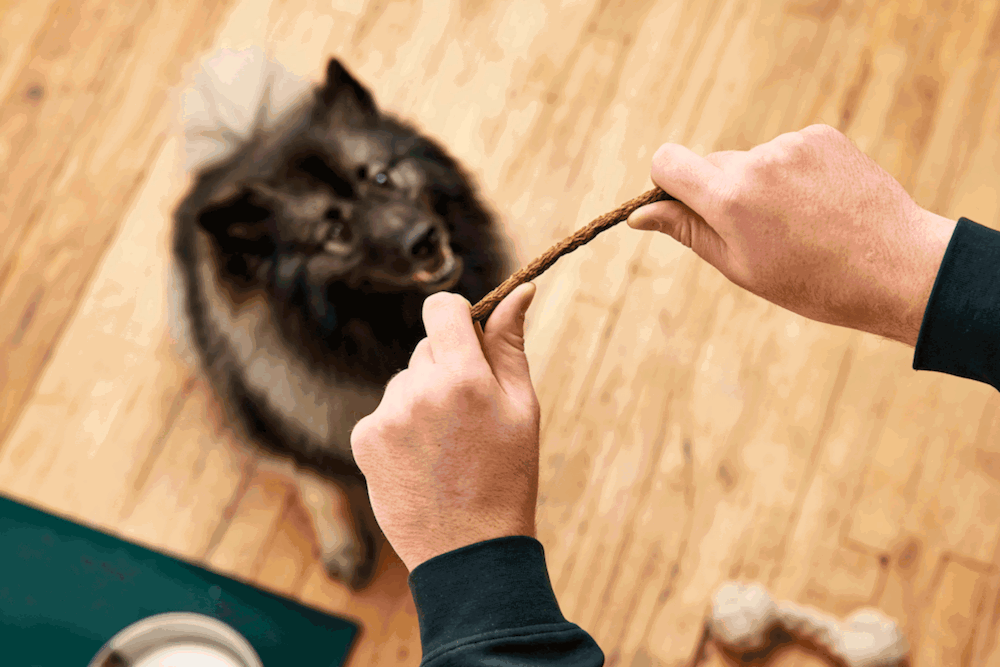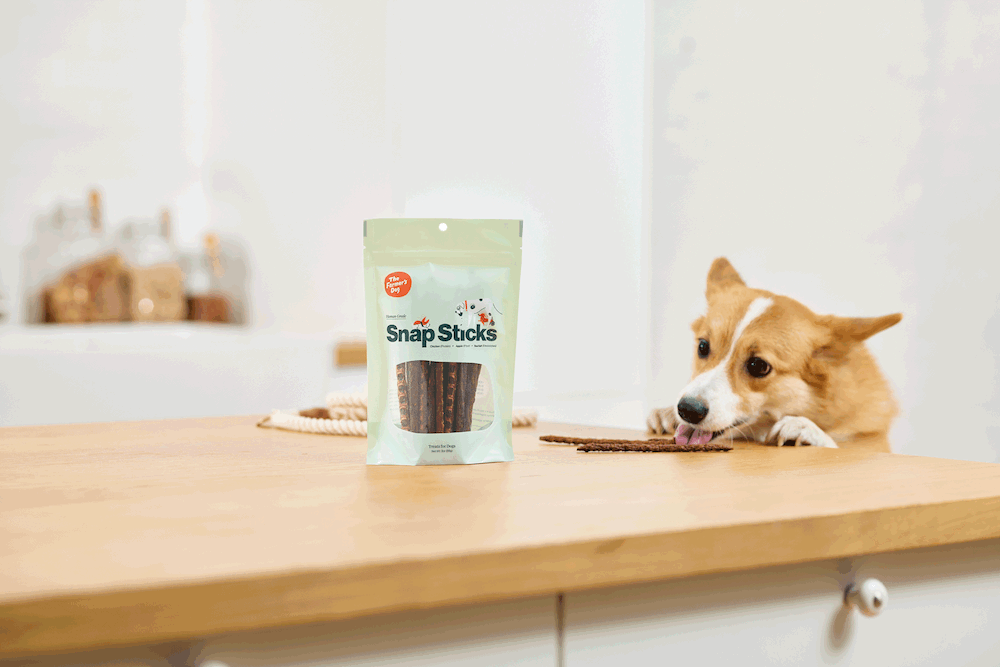Training is the cornerstone of a healthy relationship with your dog, and treats are a staple of any effective, fun training program. We all grasp the basics of treats—give your dog something tasty when you like what they’ve done—but there’s a lot that dog people can learn about how to use treats most effectively, and about which types of treats might be the best choice for their dogs.
Here are some of the top treating tips from trainers, plus why our very own Snap Sticks are a great choice for your dog’s treat needs.
Treats help you communicate with your dog
A good place to start with treats is to understand that they are among the most reliable ways to communicate with your dog. “Treats are incredibly important in dog training,” says trainer McClain Sullivan. “Food is a primary reward for dogs,” she continues, meaning that dogs inherently understand its value because it’s necessary for their survival. That makes treats an ideal way to reward a dog when you’re teaching them, sending the message that you like what they’re doing.

Treats are motivators, not bribes
“A lot of people think that we’re using treats as bribes,” says trainer Farrah Branson. But she says it’s really more about motivation and getting dogs to pay attention. Treating also “creates good associations for dogs, so we’re actually using treats to make the emotional connection from a negative to a positive,” she explains. Giving dogs treats won’t mean that they don’t listen to you when you don’t have them; in fact, when used correctly, treats will build a foundation so that your dog learns certain behaviors and can repeat them in other contexts.
As trainer Denise Herman puts it, “I can’t ‘bribe’ you right now to speak to me in Portuguese if you don’t know how to speak Portuguese.” Once you’ve taught your dog a behavior, you can start to mix in other rewards so that you don’t have to be holding something tasty in order to get them to listen.

Use treats with “markers”
One way to speed the training process along is by using a “marker”—usually a word, though it can also be a sound from a clicker, a hand signal, or anything else repeatable that a dog understands—along with a treat. Say or show the marker first, then give the treat. This lets the dog know that you liked what they did, and a reward is coming. Over time, you can associate the marker with other rewards in addition to treats—like throwing a toy or continuing forward on a fun walk. If your dog wants something, no matter what it is, giving it to them works as a reward.
Treat quickly to create the right association
A key part of the marker-plus-treat formula when you’re teaching a new behavior is to have your treats at the ready—so that when you get the behavior you want, you can mark and give the reward immediately. This means that your dog will get the message: “sitting means a treat!”
Even once your dog has mastered a skill, it’s a good idea to keep treats in the mix so they know that, every now and then, they may still hit the jackpot just for doing something that’s easy for them.
The need for consistency and good timing in rewards is one reason that it helps for treats to be small—if the treats come in easy-to-manage pieces or can be broken up into such, they’ll lend themselves to the process described above. Our Snap Sticks emphatically meet this requirement; they’re easy to separate into tiny training treats using only your hands.
We named our treats Snap Sticks because they’re a snap to portion. Each stick has “snap lines” that make it easy to break into tiny, manageable pieces with nothing but your hands—so you can be quick to reward your dog without worrying about overfeeding. Because they come in an easy-to-carry, resealable bag, you can carry Snap Sticks on you routinely, having them at the ready for whenever it’s time to give your dog an edible reward for a job well done.

Treat format matters
The trainers we spoke to all talked about how important it was for treats to be easily doled out in small pieces, because calories count no matter what your dog is eating. For very small dogs, Herman even talked about sometimes rewarding them with licks of treats and only periodically letting them eat the pieces.
Calorie concerns, plus the need for consistency and good timing in rewards are reasons that it helps for treats to be small—if the treats come in easy-to-manage pieces or can be broken up into such, they’ll lend themselves to the process described above.

Treat taste really matters
If a treat is supposed to serve as motivation and change a dog’s state of mind around certain activities, it’s crucial that it actually be something they want. The treat should be very attractive to them, because it has to compete with everything else in their world for their attention.
It’s not enough for your dog to simply accept the treat—they should actively want to get it. “If your dog’s eating it like he’s doing you a favor, it’s probably not what he really wants,” Herman says. Ideally, they should seem to be “craving it, [asking] ‘how do I get more of that?,’ [and] doing the math in their head to figure it out.”
Liver, which is in both varieties of Snap Sticks, is a big driver of palatability—making it easier to get and hold dogs’ attention during tough training tasks.
When the training difficulty level goes up—if you’ve moved your recall lessons outdoors where there are more distractions, for example—it’s important that the treats you’re using are “high-value” (that is, you know your dog absolutely loves them). Depending on what skills you’re trying to teach and how much distraction is involved (are there squirrels in the vicinity…?), you may also need to resort to something novel or extra special. Dogs, like humans, may get particularly excited about something new and great-smelling even if they still love their old favorites. Once in a while, busting out a piece of boiled chicken early in teaching a challenging training task may pay off. But, whatever you use, make sure it’s healthy and you’re not overdoing it.
And if your dog does get super motivated by play or a toy, that’s great, too. The trainers we spoke to emphasized that all dogs are food-motivated to some extent—they do need food to live, after all—but that other rewards can sometimes work well. Herman says that it’s ideal to have a mix of different rewards if only because “the dog isn’t always going to be hungry” during training.
The bottom line here is that if your dog finds it motivating and it’s healthy, your reward is a good choice. “Figure out what your dog enjoys,” says Sullivan, “and then embrace that wholeheartedly.”
Treats should be healthy
Treats are a fantastic tool, but dog obesity is a pervasive health problem. As such, you’ll have to keep track of how much you’re treating your dog. To guard against weight gain and nutritional imbalance, no more than 10% of a dog’s daily caloric intake should come from treats. If you find that you need or want to incorporate more rewards into your dog’s day than you can manage through treats alone, consider using some of your dog’s regular food in training tasks as well. Many dogs find it rewarding to work for their food. While you shouldn’t withhold food from a dog because they won’t work, there’s a good chance that yours would enjoy certain brain games and other activities that could be incorporated into meal times.
Also because you’ll be feeding your dog treats frequently, you should pay attention to what they’re made out of. Look for treats with a small number of simple, whole ingredients. If you wouldn’t tolerate an ingredient or a cooking method in your dog’s regular food, you don’t want it in their treats. “In general, I always recommend using limited ingredient treats,” says Sullivan. “There are a lot of dog treats that have fillers—and, especially when working puppies, I like to keep it as simple as possible so as not to upset sensitive stomachs.”
Snap Sticks are made to the same human-grade standards as The Farmer’s Dog food. They don’t have the added sugars, gums, “natural flavors,” and flours that many treats do—they’re made with only USDA-certified meat, vitamin-packed whole fruits, and a tiny bit of sea salt for electrolytes. So you can feel confident that they’re good for your dog’s training and health.
Treats work in more situations than you might expect
One common way of thinking about treats is that if you give a dog a treat while they’re doing something, you’ll get more of it. But that’s not always the case: counterconditioning involves pairing something your dog likes (such as a treat) with something they don’t like (such as the sound of a doorbell) to change their association with the negative stimulus. Herman explains that, when you’re engaging in counterconditioning, it’s okay to give a dog a treat if they’re barking or otherwise agitated—as long as you know it’s an emotional reaction and not an active attempt to get you to give them something. The trick is to read your dog’s behavior and figure out their state of mind, and a professional may be helpful in doing so if you aren’t sure about it.
Herman phrases the question this way: “Are you barking at that sandwich because you want the sandwich, or are you barking at me holding an umbrella because you’ve never seen an umbrella?” If it’s the latter, you can safely treat your dog and expect to get less barking in the long term, not more… because you’re helping to change their mindset around the unfamiliar object. If your dog is demand barking for a sandwich, you’ll have to help them learn that there are better ways of getting what they want. And good news: treats are very useful on that front as well.
Another treat fact that may surprise you is that you can give your dog a treat for no reason (sort of). The idea you may have heard that “nothing in life should be free” for a dog is not really true. As long as your dog isn’t doing anything you don’t want them to keep doing—demand barking, walking on your furniture, jumping up if that’s against the rules—you can go ahead and give them treats seemingly at random. This sends the message that good things may happen to them from time to time when they exist calmly in your company, and helps strengthen your bond.
The post Why Treats Are Essential in Dog Training, And Why Snap Sticks are a Good Choice appeared first on The Farmer's Dog.

Comments
Post a Comment